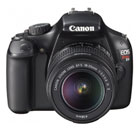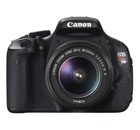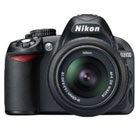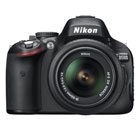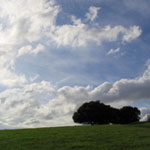| Back to Back Issues Page |
 |
|
Digital SLR Guide Newsletter - Holiday Camera Guide November 27, 2011 |
Having trouble viewing this newsletter? Read the latest issue online at
/dslr-news.html or read back issues If someone you know has forwarded you this newsletter and you've enjoyed it, subscribe now to receive the next issue when it's published.
DSLR News - November 2011
In This Issue
In preparation for the upcoming holiday season, this issue will be all about cameras.
I'll provide a brief introduction to the latest models from different manufacturers and will talk about some of the key differences between them.
You can click any camera name link for more detailed information on the models that I describe below.
Stay Updated!The Digital SLR Guide is also on Facebook. If you're on Facebook, drop on by to get updates about new digital SLR cameras and photo tips.Canon Digital SLRs
Let's kick off this issue with Canon — since I always get a lot of questions about these cameras.
When it comes to Canon digital SLRs, there are three primary levels: basic, intermediate and advanced. The three cameras that fall into each of these categories are the Rebel T3 1100D, the Rebel T3i 600D and the Canon 60D.
If you'd like the image quality of a digital SLR but are intimidated by all the controls on these cameras, then the Rebel T3 1100D is a good starting point.
Digital SLRs capture high-quality images for two reasons: they have large sensors and you customize your lens choice to match the subject.
The T3 includes both of these, so there's no need to worry about compromising on "quality" if you decide to go with this camera. Really, the main thing that you are giving up is the ability to fine-tune each camera setting.
Advanced photographers who spend a lot of time in manual mode appreciate the ability to tweak every setting included in the camera. Since beginners won't need such things, they are left out of the T3.
If you'd like a taste of some of these more advance settings AND a flexible 3 inch LCD screen, then consider the Rebel T3i 600D.
The T3i is also a better choice than the T3 if you'd like more control over the video capture. With the ability to capture Full High Definition 1080p video, the T3i also lets you select the frame rate so that you can mimic the look of film cameras (which capture at a speed of 24 frames per second).
If you've used other SLR cameras in the past or have a good working knowledge of aperture, shutter speed, ISO and white balance, then you can opt for the Canon 60D.
This is the most advanced camera of the three, but it shares a great number of features with the T3i (same megapixels, same video, same flexible LCD screen).
Because of this overlap with the T3i, the 60D should really only be on your short list if you need just a bit more speed from your SLR. For example, if you plan to constantly take pictures of mountain bike races in dim light, then you'll get better results with the 60D — but ONLY if you know how to customize its settings for maximum performance.
Beginner Digital SLR Lessons
Nikon Digital SLRs
In a past issue of this newsletter, I provided an in-depth analysis of the three current consumer Nikon cameras you can choose from, so I'll be brief here.
Like Canon, Nikon has three different levels of camera: D3100 (beginner), D5100 (intermediate) and the D7000 (advanced).
The D3100 is designed with the beginning SLR photographer in mind. If you're just making the move from a compact digital camera, then consider the D3100 for its simplicity and ease-of-use.
Don't be concerned about the "lack" of megapixels - with 14.2, the D3100 can easily make super-size prints with exceptional image quality.
The main reason to make the move up to a D5100 is for its flexible LCD screen. Flexible LCDs are very useful for high and low-angle shots, and they make capturing video significantly easier since you don't always have to hold the camera at eye level.
If making independent short films or taking lots of high-speed action shots is your thing, then consider a further step up to the D7000.
The D7000 has a professional grade build quality and it comes with a feature set to justify its price tag. If you don't feel that you'll ever be customizing your while balance, using two memory cards at once or shooting with multiple off-camera flash units, then the D7000 is probably more camera than you really need.
Pentax Digital SLRs
Pentax enthusiasts have one choice to make: basic or advanced.
The more basic model is the Pentax K-r. And by "basic" I don't mean that it's severely lacking: the K-r includes built-in image stabilization, weather proofing, 720p video, an 11-point autofocus and a speedy 6 photo-per-second capture speed.
I just mean that it's basic when you compare it to the Pentax K-5.
At the time of writing the Pentax K-5 still holds a unique distinction: it has the greatest ISO range of any digital SLR currently available, from a low of 80 to a high of 51200.
Pair this with stabilization built into the camera body, and you've got a camera that can practically see in the dark.
Landscape photographers can take advantage of an included High Dynamic Range (HDR) feature and an electronic level to keep those pesky horizon lines flat.
While both cameras have a lot to offer, the K-5 just has more to satisfy the more advanced photographer. Whether you are one now or want to become one in the future might help drive your decision between these two Pentax models.
Intermediate Digital SLR Lessons
Sony Digital SLRs
There are two types of Sony cameras: Single Lens Reflex (SLR) and Single Lens Translucent (SLT).
The difference between the two is the mirror that sits in front of the camera's sensor: in one case that mirror reflects 100% of the light up to the optical viewfinder (just like any other SLR) and in another some light is reflected while some light passes through to the sensor (translucent mirror).
While SLT cameras replace the optical viewfinder with an electronic one, they come with a substantial benefit: autofocus in live view mode and when taking movies is exceptionally fast. With "true" SLR cameras, autofocus in live view is glacially slow — to the point where it's really only useful for landscape photography or portraits if your subject can stay still.
So the question boils down to this: would you rather take still images using an optical viewfinder or capture stills and video primarily using the camera's LCD?
If an optical viewfinder is important to you and you don't think you'll use your SLR for video all that much, then the two cameras to choose from are the Sony A560 and the A580. Virtually identical, the main difference between these two is megapixels: the A560 has 14.2 and the A580 has 16.2.
If you're keen to capture both video and stills with one camera, then consider the SLT-A65 or the more advanced SLT-A77.
The SLT-A65 includes a host of features: 15-point autofocus, sweep panorama mode, auto HDR, Full HD 1080p video capture, flexible LCD and the ability to capture 10 consecutive photos per second.
The SLT-A77 has a similar feature set, but goes even faster thanks to its 19 point autofocus and 12 photo-per-second continuous speed. Location junkies will be pleased with the onboard GPS that records location data (longitude and latitude) for every photo you take.
Photo Links
Photo Contests
Other Photography Sites
Great Photo Blogs
In Conclusion
Some readers may notice that I haven't mentioned Olympus at all in the above summary.
This is because Olympus currently only has one digital SLR camera, and it was released over a year ago: the Olympus E-5.
Olympus has shifted their focus away from digital SLRs and appears to be spending more time developing their line of mirrorless cameras.
As for the next issue of this newsletter, the focus will be on lenses. You can expect to receive that within the next couple of weeks so you'll still have plenty of time to get a gift for a loved one or maybe even for yourself.
Until then, happy picture-taking!
--Chris Roberts, Your Digital SLR Guide
|
| Back to Back Issues Page |

